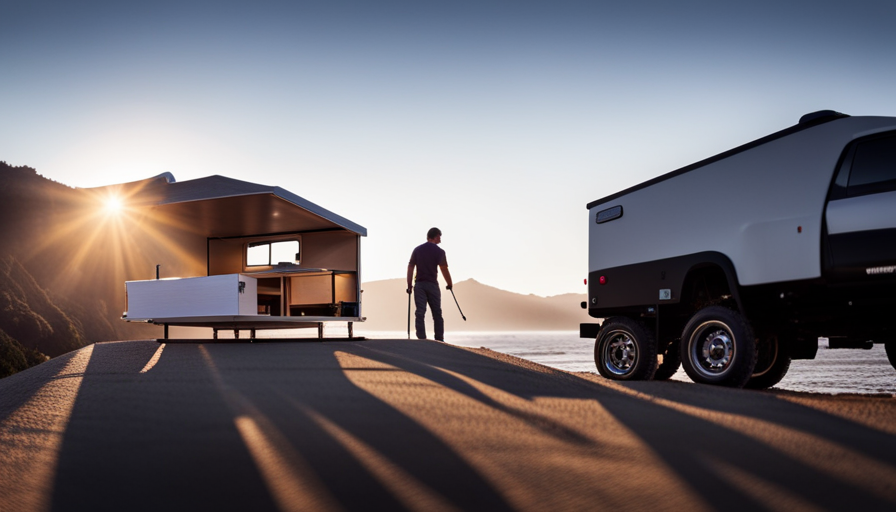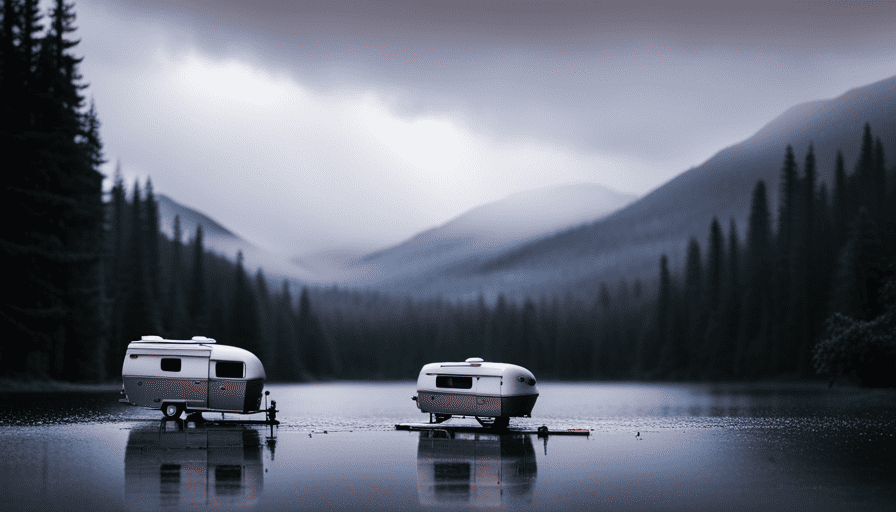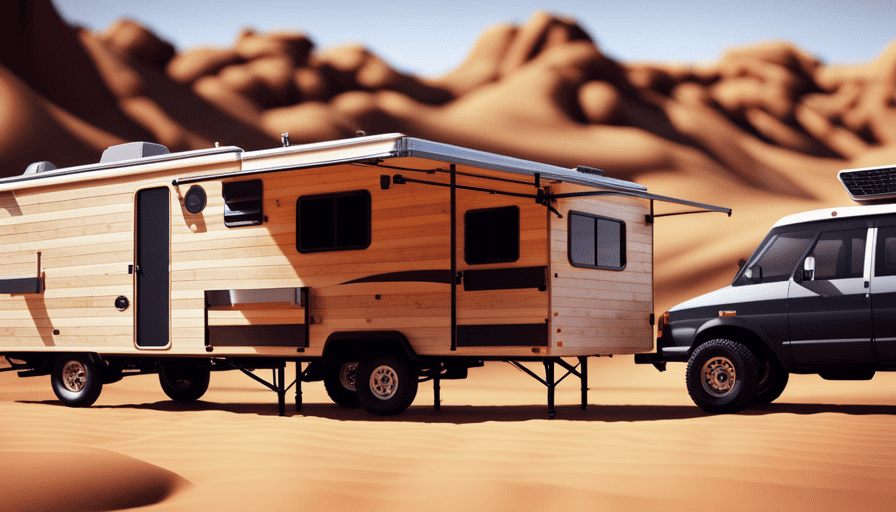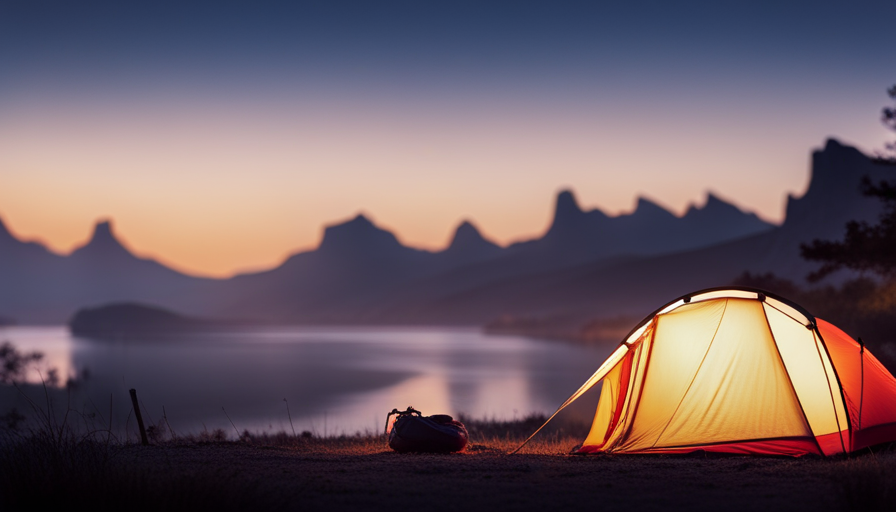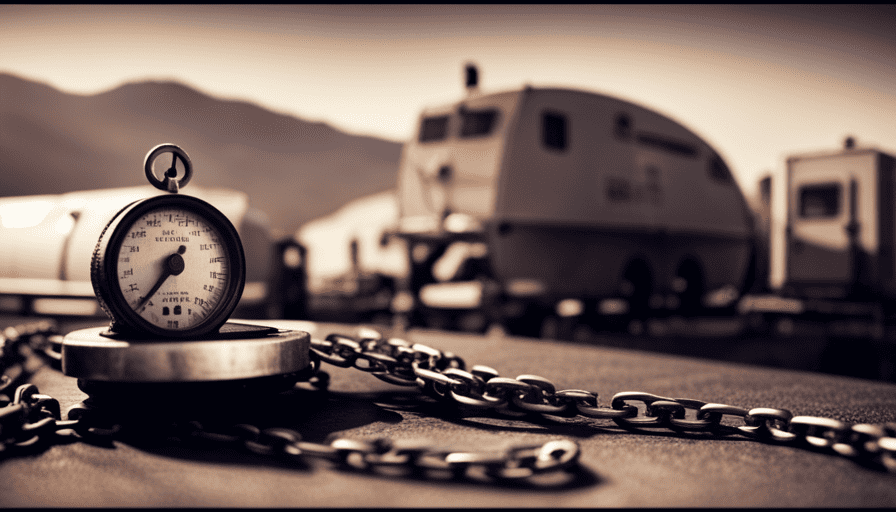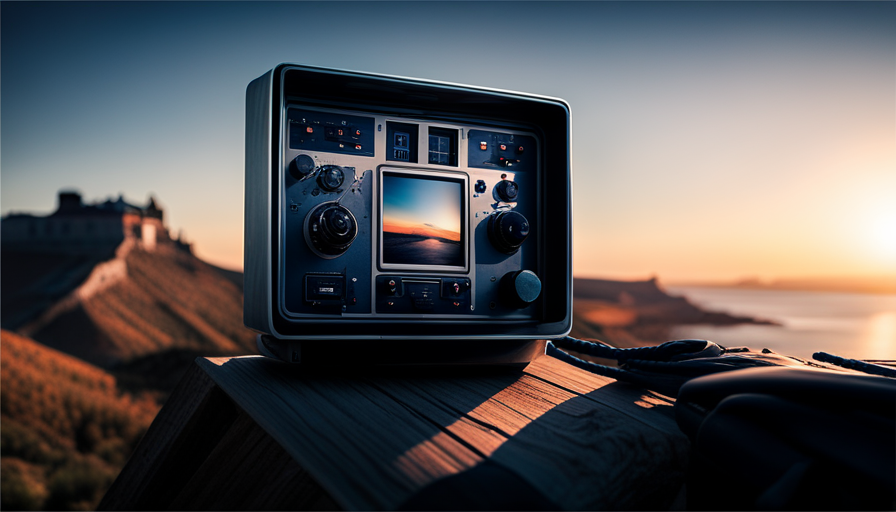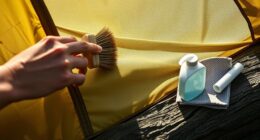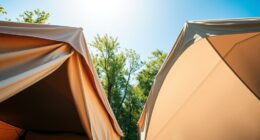Imagine yourself driving down the open road, feeling completely free and at ease, in your own mobile home. This is the appeal of a truck camper.
Whether you’re a seasoned traveler or a weekend adventurer, creating your own truck camper allows you to tailor it to your specific needs and style.
In this article, I will guide you through the step-by-step process of making your own truck camper, from designing the layout to adding the finishing touches. I’ll share my knowledge and expertise, ensuring that you have all the information you need to tackle this exciting DIY project.
With a little creativity and some basic tools, you’ll be able to transform your truck into a cozy and functional mobile living space.
So, let’s dive in and get started on this thrilling journey of building your very own truck camper!
Key Takeaways
- Customization: A truck camper allows for customization to specific needs and style, providing freedom and comfort on the road.
- Space optimization: Utilize multi-purpose furniture, vertical space, and storage solutions to optimize the limited space in a truck camper.
- Materials and construction: Choose lightweight yet sturdy materials for the frame and flooring, and consider insulation, moisture resistance, and ease of maintenance.
- Functional amenities: Install plumbing and water systems, choose energy-efficient appliances, add windows and vents for natural light and ventilation, and personalize the space with paint and decor.
Determine Your Design and Layout
Now that you’ve gathered all your materials and tools, it’s time to envision the perfect design and layout for your dream truck camper.
When it comes to designing your camper, there are a few key considerations to keep in mind. First, think about the size and weight of your truck. This will determine the overall dimensions and layout of your camper. You want to make sure it fits securely on your truck without compromising its stability.
Additionally, consider the number of people who will be using the camper and their needs. This will help you determine the number of sleeping areas, seating arrangements, and storage options you’ll need.
Space optimization is crucial in a truck camper. You want to make the most out of every square inch. Consider using multi-purpose furniture, such as a bed that can convert into a seating area during the day. Utilize vertical space by installing shelves or cabinets that go up the walls. Think about the flow of the space and make sure there is enough room to move around comfortably. Don’t forget to incorporate storage solutions for your belongings, such as drawers or bins.
With your design and layout in mind, it’s time to gather the materials and tools needed to bring your vision to life.
Gather Materials and Tools
First, you’ll want to gather all the necessary supplies and equipment for building your truck camper. Choosing the right materials is crucial to ensure durability and functionality. Look for lightweight yet sturdy materials that can withstand the demands of the road. Common options include plywood, aluminum, fiberglass, and foam insulation. Don’t forget to consider factors like insulation, moisture resistance, and ease of maintenance when making your choices.
Finding the necessary tools is the next step. You’ll need a variety of tools to complete the project, such as a circular saw, drill, jigsaw, screws, nails, measuring tape, and a level. Make sure you have all the tools required before starting the construction to avoid any unnecessary delays.
Once you have gathered all the materials and tools, you can proceed to build the frame and floor of your truck camper. This step is crucial as it provides the foundation for the entire structure. By carefully constructing a sturdy frame and secure flooring, you’ll ensure the stability and safety of your camper.
Build the Frame and Floor
After gathering the necessary materials and tools, it’s time to start constructing the frame and floor of your DIY truck camper. Before diving into the construction process, it’s important to consider the design aspects of your camper. Think about the size and weight limitations of your truck and how that’ll affect the overall design.
Additionally, consider the floor plan options that’ll best suit your needs and preferences. Do you want a compact camper with a minimalistic layout, or do you prefer a more spacious design with room for additional amenities?
Once you have a clear vision for your camper, it’s time to begin building the frame and floor. Start by measuring and cutting the lumber according to the dimensions outlined in your design. Use a combination of screws, bolts, and brackets to securely attach the pieces together. Reinforce the joints with metal plates to ensure stability and durability.
As you construct the frame, keep in mind any additional features you plan to incorporate later, such as storage compartments or seating areas.
As you finish constructing the frame and floor, it’s important to transition into the next step of the process: installing insulation and wiring. By insulating your camper, you’ll ensure that it remains comfortable in various weather conditions. Wiring is essential for powering any electrical components you plan to include in your camper.
Install Insulation and Wiring
To create a cozy and functional space, it’s crucial to insulate your DIY truck camper and wire it for all your electrical needs. Proper insulation ensures that you stay warm in the winter and cool in the summer, while the wiring allows you to power your appliances and devices on the go. Here are some wiring techniques and insulation options to consider:
-
Wiring Techniques:
- Plan your electrical layout: Determine where you want your outlets, lights, and other electrical components to be located.
- Use marine-grade wiring: It’s designed to withstand the vibrations and harsh conditions of the road.
- Install a fuse box: This helps protect your electrical system from overloads and short circuits.
- Ground your electrical system: This ensures safety and prevents electrical shocks.
-
Insulation Options:
- Spray foam insulation: Provides excellent insulation and seals gaps to prevent air leakage.
- Reflective insulation: Reflects heat away from the camper and keeps it cooler in hot climates.
- Fiberglass insulation: Easy to install and provides good thermal insulation.
By following these wiring techniques and insulation options, you can create a comfortable and efficient living space in your truck camper.
In the next section, we will discuss how to build and install furniture and storage to maximize the functionality of your camper.
Build and Install Furniture and Storage
Crafting a cozy and functional living space in your DIY truck camper involves skillfully creating and installing furniture and storage options.
When it comes to furniture, there are various options to consider. One popular choice is to build a convertible sofa or bed that can easily transform into a comfortable seating area during the day and a cozy sleeping space at night.
Another option is to install a fold-out table that can be used for dining or as a workspace. Additionally, you can incorporate built-in cabinets and shelves to maximize storage space. These can be used to store kitchen essentials, clothing, and other items you may need during your travels.
In terms of storage solutions, it is important to make the most of the limited space available in a truck camper. Utilizing overhead compartments is a great way to store items that you don’t need to access frequently.
You can also install hanging storage pockets on the inside of doors or walls to keep smaller items organized and easily accessible. Another clever storage option is to utilize the space under the bed or seating area by installing drawers or pull-out bins.
With the furniture and storage options in place, the next step is to install the plumbing and water system, which will allow you to have a fully functional camper on the road.
Install Plumbing and Water System
Create a flowing river of convenience by installing a plumbing and water system to keep your cozy oasis refreshed and rejuvenated. When it comes to setting up your truck camper’s plumbing and water system, there are a few key considerations to keep in mind. Here are some important steps to follow:
-
Begin by choosing the right water filtration option for your needs. There are various options available, such as carbon filters or reverse osmosis systems, that can help ensure the water you use in your camper is clean and safe.
-
Next, install a water pump to provide a steady flow of water to your faucets and shower. Make sure to choose a pump that’s compatible with your camper’s electrical system and has enough power to meet your water usage needs.
-
Finally, don’t forget about water conservation. Since you’ll likely have limited water storage capacity in your camper, it’s important to be mindful of your water usage. Consider using low-flow faucets and showerheads, and be conscious of how much water you use for tasks like washing dishes or taking showers.
By following these steps, you can create a reliable and efficient plumbing and water system in your truck camper.
In the next section, we’ll explore how to add appliances and amenities to make your camper even more comfortable and functional.
Add Appliances and Amenities
Enhance your cozy oasis on wheels by adding appliances and amenities that’ll make your truck camper feel like a luxurious home away from home. When it comes to choosing the right appliances, it’s important to consider their size, power source, and functionality. Compact options like mini-fridges, microwaves, and portable stoves are ideal for conserving space while still providing the convenience of a kitchen on the road.
Additionally, investing in energy-efficient appliances that can run on multiple power sources, such as solar panels or propane, will ensure that you have the flexibility to camp off-grid without sacrificing comfort.
Maximizing space for amenities is crucial in a truck camper, where every inch counts. Look for multi-purpose furniture that can serve as storage and seating, such as benches with built-in compartments or tables that can be folded when not in use.
Adding amenities like a portable toilet or a compact shower can also greatly enhance your camping experience.
As you start to add appliances and amenities to your truck camper, it’s important to consider how they’ll impact the overall layout and design.
In the next section, we’ll discuss how to install windows and ventilation to ensure proper airflow and natural light in your cozy home on wheels.
Install Windows and Ventilation
To truly transform your cozy oasis on wheels into a luxurious home away from home, you’ll want to install windows and ventilation that allow for refreshing airflow and fill your space with natural light.
When it comes to window types, there are a few options to consider. Fixed windows are a popular choice as they provide a clear view and are easy to install. Sliding windows are another option, allowing you to easily open and close them for ventilation. If you prefer a more modern look, consider installing awning windows, which can be opened even when it’s raining.
In addition to windows, proper ventilation is essential in a truck camper. Installing vents, such as roof or side vents, will help circulate air and prevent condensation buildup. You may also want to consider installing a fan, such as a roof fan or a portable fan, to improve airflow even further.
With windows and ventilation in place, your truck camper will be ready for the next step: painting and decorating. By adding a personal touch with colors and decor, you can truly make your camper feel like a cozy and inviting space.
Paint and Decorate
Once you’ve installed windows and ventilation, it’s time to add your personal touch with a splash of color and decorative elements, transforming your cozy oasis on wheels into a stylish and inviting home away from home.
Did you know that studies have shown that incorporating vibrant colors and playful patterns into your living space can boost your mood and overall well-being?
When it comes to painting your truck camper, there are various techniques you can use to achieve the desired look. Whether you prefer a rustic, vintage vibe or a modern, sleek aesthetic, the choice is yours. Consider using techniques like color blocking, where you paint different sections of the walls in contrasting colors to create visual interest. Another option is stenciling, which allows you to add intricate patterns or designs to your walls. This can be a fun DIY project that adds a unique touch to your camper.
In addition to paint, don’t forget about the power of accessories and decor. Incorporate elements like throw pillows, curtains, and rugs that match your chosen color scheme and enhance the overall ambiance. Consider hanging artwork or photographs that reflect your personality and interests. The key is to create a space that feels comfortable, cozy, and reflective of your personal style.
Now that your truck camper is painted and decorated to perfection, it’s time to test and enjoy your new home on wheels.
Test and Enjoy Your New Truck Camper
Indulge in the ultimate adventure and take your newly transformed home on wheels for a spin, immersing yourself in the breathtaking landscapes and endless possibilities that await you.
Now that your truck camper is complete, it’s time to test it out and enjoy all the hard work you’ve put into it. Before hitting the road, it’s important to troubleshoot any common issues that may arise. Check all the electrical connections, plumbing, and propane systems to ensure everything is in working order. Make sure to test the stability of your camper and ensure that it is securely attached to your truck. This will help prevent any potential issues while on the road.
Once you’re on your way, be sure to follow some maintenance tips to keep your truck camper in top shape. Regularly inspect the exterior for any signs of wear and tear, such as cracks or leaks. Keep an eye on the tires and make sure they’re properly inflated. Additionally, clean and sanitize the water system regularly to avoid any buildup or contamination.
With your truck camper ready to go, you can now embark on unforgettable adventures. Whether it’s a cross-country road trip or a weekend getaway, your new home on wheels will provide comfort and convenience wherever you go.
So, hit the road and enjoy the freedom that comes with owning a truck camper.
Frequently Asked Questions
How much does it typically cost to build a truck camper?
Typically, the cost of building a truck camper can vary depending on the building materials and the level of interior design you choose.
Building materials such as plywood, insulation, and aluminum can range from a few hundred to a few thousand dollars.
Interior design elements like furniture, appliances, and fixtures can also vary in cost.
It’s important to budget for these expenses and research prices to ensure you stay within your desired budget.
Can a truck camper be easily removed from the truck bed?
Removing a truck camper from the truck bed is a breeze! With a simple and efficient removing process, you can easily detach the camper whenever you need. It’s like taking candy from a baby!
Once removed, you’ll have plenty of storage options available. You can store it in your garage or backyard, or even rent a storage space if needed. The possibilities are endless!
What are some common challenges faced when building a truck camper?
Common design obstacles when building a truck camper include limited space, weight constraints, and structural integrity.
Maximizing space is crucial, so I recommend using multi-functional furniture like convertible beds and collapsible tables. Additionally, consider utilizing vertical storage solutions and organization systems to make the most of the available space.
It’s also important to carefully plan the layout to ensure proper weight distribution and stability while on the road.
Are there any regulations or permits required for using a truck camper?
Yes, there are regulations and permits required for using a truck camper. The specific regulations and permits may vary depending on your location, but generally, there are rules regarding parking, camping, and vehicle modifications.
Some areas may require permits for overnight parking or camping in certain locations, while others may have restrictions on the size or weight of the camper. It’s important to research and comply with all local regulations and obtain any necessary permits before using a truck camper.
How can I ensure that my truck camper is safe and secure while driving on the road?
To ensure stability and secure your belongings while driving with a truck camper, there are a few important steps to follow. First, make sure that your camper is properly loaded and balanced, distributing the weight evenly. This will help maintain stability on the road.
Additionally, use high-quality tie-downs and straps to secure your belongings inside the camper. This will prevent any shifting or damage during travel. Regularly check these tie-downs and straps to ensure they’re tight and secure throughout your journey.
What Type of Truck Camper Would be Best for DIY Building?
If you’re planning to embark on a DIY project to build your own truck camper, it’s crucial to consult a reliable camper truck compatibility guide. This guide will assist you in selecting the best type of truck camper that suits your DIY building needs. It provides essential information on truck dimensions, weight capacities, bed lengths, and other specifications, ensuring a successful camper building endeavor.
Conclusion
In conclusion, building a truck camper is a rewarding and fulfilling project that allows you to customize your own mobile home on wheels. With the right materials, tools, and a little bit of know-how, you can create a comfortable and functional living space for your adventures on the road.
Did you know that approximately 64% of truck camper owners choose to build their own camper rather than buying a pre-made one? This statistic shows the growing popularity of DIY truck camper projects and the sense of pride that comes with creating something unique.
So go ahead and start building your dream truck camper today!

